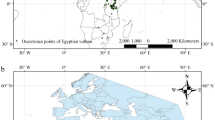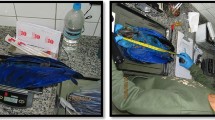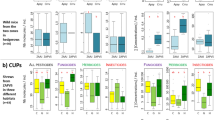Abstract
The Oriental white-backed vulture (OWBV; Gyps bengalensis) was once one of the most common raptors in the Indian subcontinent1. A population decline of >95%, starting in the 1990s, was first noted at Keoladeo National Park, India2. Since then, catastrophic declines, also involving Gyps indicus and Gyps tenuirostris, have continued to be reported across the subcontinent3. Consequently these vultures are now listed as critically endangered by BirdLife International4. In 2000, the Peregrine Fund initiated its Asian Vulture Crisis Project with the Ornithological Society of Pakistan, establishing study sites at 16 OWBV colonies in the Kasur, Khanewal and Muzaffargarh–Layyah Districts of Pakistan to measure mortality at over 2,400 active nest sites5. Between 2000 and 2003, high annual adult and subadult mortality (5–86%) and resulting population declines (34–95%) (ref. 5 and M.G., manuscript in preparation) were associated with renal failure and visceral gout. Here, we provide results that directly correlate residues of the anti-inflammatory drug diclofenac with renal failure. Diclofenac residues and renal disease were reproduced experimentally in OWBVs by direct oral exposure and through feeding vultures diclofenac-treated livestock. We propose that residues of veterinary diclofenac are responsible for the OWBV decline.
This is a preview of subscription content, access via your institution
Access options
Subscribe to this journal
Receive 51 print issues and online access
$199.00 per year
only $3.90 per issue
Buy this article
- Purchase on Springer Link
- Instant access to full article PDF
Prices may be subject to local taxes which are calculated during checkout

Similar content being viewed by others
References
Ali, S. & Ripley, S. D. Handbook of the Birds of India and Pakistan Together With Those of Nepal, Bhutan, and Ceylon I. Divers to Hawks (Oxford Univ. Press, Oxford, 1968)
Prakash, V. Status of vultures in Keoladeo National Park, Bharatpur, Rajasthan, with special reference to population crash in Gyps species. J. Bombay Nat. Hist. Soc. 96, 365–378 (1999)
Pain, D. et al. Causes and effects of temporospatial declines of Gyps vultures in Asia. Conserv. Biol. 17, 661–671 (2003)
BirdLife International. Threatened Birds of Asia: the BirdLife International Red Data Book (BirdLife International, Cambridge, 2001)
Gilbert, M. et al. Breeding and mortality of Oriental White-backed vulture Gyps bengalensis in Punjab Province, Pakistan. Bird Conserv. Int. 12, 311–326 (2002)
Crespo, R. & Shivaprasad, H. L. in Diseases of Poultry 11th edn (ed. Saif, Y. M.) 1085–1087 (Iowa State Press, Ames, 2003)
Beyer, W., Heinz, G. & Redmon-Norwood, A. (eds) Environmental Contaminants in Wildlife. Interpreting Tissue Concentrations Ch. 10, 11, 14, 17 (CRC Press, Boca Raton, 1996)
Swayne, D. E. & Slemons, R. D. Comparative pathology of a chicken-origin and two-duck origin influenza virus isolates in chickens: the effect of route of inoculation. Vet. Pathol. 31, 237–245 (1994)
Ziegler, A. F. et al. Nephropathogenic infectious bronchitis in Pennsylvania chickens 1997–2000. Avian Dis. 46, 847–858 (2002)
Steele, K. E. et al. Pathology of fatal West Nile virus infections in native and exotic birds during the 1999 outbreak in New York City, New York. Vet. Pathol. 37, 208–224 (2000)
Todd, P. A. & Sorkin, E. M. Diclofenac sodium. A reappraisal of its pharmacodynamic and pharmacokinetic properties, and therapeutic efficacy. Drugs 35, 244–285 (1988)
Nys, Y. & Rzasa, J. Increase in uricemia induced by indomethacin in hens or chickens. C. R. Séances Acad. Sci. III 296, 401–404 (1983)
Paul-Murphy, J. & Ludders, J. W. Avian analgesia. Vet. Clin. N. Am. Exotic Anim. Prac. 4, 35–45 (2001)
Murray, M. D. & Brater, D. C. Renal toxicity of the nonsteroidal anti-inflammatory drugs. Annu. Rev. Pharmacol. Toxicol. 33, 435–465 (1993)
Gatome, C. W. Haematology and Blood Biochemistry in Free-Living African White-Backed Vultures Gyps africanus in Kenya (MSc, Univ. London, 2002)
Tixier, C., Singer, H. P., Oellers, S. & Muller, S. R. Occurrence and fate of carbamazepine, clofibric acid, diclofenac, ibuprofen, ketoprofen, and naproxen in surface waters. Environ. Sci. Technol. 37, 1061–1068 (2003)
Baert, K. & De Backer, P. Comparative pharmacokinetics of three non-steroidal anti-inflammatory drugs in five bird species. Comp. Biochem. Physiol. C 134, 25–33 (2003)
Daughton, C. G. & Ternes, T. A. Pharmaceuticals and personal care products in the environment: agents of subtle change. Environ. Health Perspect. 107, 907–938 (1999)
Henny, C. J., Blus, L. J., Kolbe, E. J. & Fitzner, R. E. Organophosphate insecticide (famphur) topically applied to cattle kills magpies and hawks. J. Wildl. Mgmt 49, 648–658 (1985)
Langelier, K. M. in Raptor Biomedicine (eds Redig, P. T., Cooper, J. E., Remple, J. D. & Hunter, D. B.) 231–232 (Univ. Minnesota, Minneapolis, 1993)
McKellar, Q. A. Ecotoxicology and residues of anthelmintic compounds. Vet. Parasitol. 72, 413–435 (1997)
Cunningham, A. A. et al. Indian vultures: victims of an infectious disease epidemic? Anim. Conserv. 6, 189–197 (2003)
Mishra, S. K. et al. Vulture mortality: pathological and microbiological investigations. Indian J. Anim. Sci. 72, 283–286 (2002)
Ellman, G. L., Courtney, K. D., Andres, V. & Featherstone, R. M. A new and rapid colorimetric determination of acetylcholinesterase activity. Biochem. Pharmacol. 7, 88–95 (1961)
Hill, E. F. & Fleming, W. J. Anticholinesterase poisoning of birds: field monitoring and diagnosis of acute poisoning. Environ. Toxicol. Chem. 1, 27–38 (1982)
Dochertry, D. E. & Slota, P. G. Use of muscovy duck embryo fibroblasts for the isolation of viruses from wild birds. J. Tissue Cult. Methods 11, 165–170 (1988)
Kwon, H. M., Jackwood, M. W. & Gelb, J. Differentiation of infectious bronchitis virus serotypes using polymerase chain reaction and restriction fragment length polymorphism analysis. Avian Dis. 37, 194–202 (1993)
Lee, M. S., Chang, P., Shien, J., Cheng, M. & Shieh, H. K. Identification and subtyping of avian influenza viruses by reverse transcription-PCR. J. Virol. Methods 97, 13–22 (2001)
Johnson, D. J., Ostlund, E. N., Pedersen, D. D. & Schmitt, B. J. Detection of North American West Nile virus in animal tissue by a reverse transcription-nested polymerase chain reaction assay. Emerg. Inf. Dis. 7, 739–741 (2001)
Mendenhall, M. K. et al. Detection and differentiation of Mycobacterium avium and Mycobacterium genavense by polymerase chain reaction and restriction enzyme digestion analysis. J. Vet. Diagn. Invest. 12, 57–60 (2000)
Acknowledgements
The authors thank S. Pritchard, S. Donahoe and M. Asim for technical assistance, and T. Taruscio and HEJ Laboratories (Karachi) for performing diclofenac assays. We thank V. Beasley, K. Beckman, P. Benson, T. Besser, T. Cade, K. Mealey, R. Poppenga, P. Talcott, The Ornithological Society of Pakistan, Punjab Department of Wildlife and Parks, the National Council for the Conservation of Wildlife (Islamabad), World Wildlife Fund (Pakistan), and Brigadier M. Ahmed for their cooperation. This research was conducted as part of The Peregrine Fund's Asian Vulture Crisis Project and was supported by the Gordon and Betty Moore Foundation, The Peregrine Fund, Disney Wildlife Conservation Fund, San Diego Zoological Society, and the United Nations, Ivorybill and Summit Foundations.Authors' contributions J.L.O. coordinated the overall diagnostic work and performed microbiology; M.G., M.Z.V. and A.A.K. coordinated field biology and collected samples; R.T.W. supervised field biology; C.U.M., B.A.R. and H.L.S. performed pathology; and S.A., M.J.I.C., M.A. and A.A. collected biology data and samples.
Author information
Authors and Affiliations
Corresponding author
Ethics declarations
Competing interests
The authors declare that they have no competing financial interests.
Supplementary information
Rights and permissions
About this article
Cite this article
Oaks, J., Gilbert, M., Virani, M. et al. Diclofenac residues as the cause of vulture population decline in Pakistan. Nature 427, 630–633 (2004). https://doi.org/10.1038/nature02317
Received:
Accepted:
Published:
Issue Date:
DOI: https://doi.org/10.1038/nature02317
This article is cited by
-
Assessment of chlorinated pesticide exposure to white-rumped vulture Gyps bengalensis in India
Environmental Science and Pollution Research (2024)
-
Recent advances of nanomaterials for non-steroidal anti-inflammatory drugs removal from wastewater: a critical review
Clean Technologies and Environmental Policy (2024)
-
Drug take-back program: assessment of knowledge, practices, and barriers to safe disposal of unused medication among healthcare students in a Nigerian university
BMC Medical Education (2023)
-
The first ecological contamination study of avian mercury and lead in southeast Iran, Hamun International Wetlands
Environmental Science and Pollution Research (2023)
-
A non-steroidal drug “diclofenac” is a substrate for electrochemical degradation process using graphite anode
Environmental Monitoring and Assessment (2023)
Comments
By submitting a comment you agree to abide by our Terms and Community Guidelines. If you find something abusive or that does not comply with our terms or guidelines please flag it as inappropriate.



